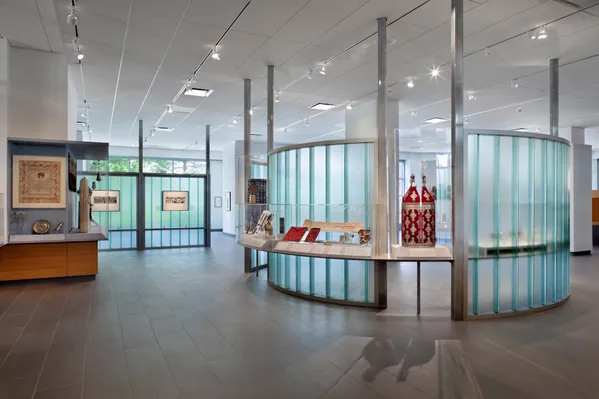
Derfner Judaica Museum + The Art Collection at Hebrew Home at Riverdale
5901 Palisade Ave, Bronx, NY 10471 - United States
The primary mission of the Derfner Judaica Museum + The Art Collection at Hebrew Home at Riverdale is to collect and display fine art and Jewish ceremonial objects and to interpret its collections for the public. The Museum, founded in 1982, and The Art Collection provide publicly accessible art programming under the auspices of Hebrew Home at Riverdale, whose cultural programs are a model of universal accessibility with a special focus on the elderly and persons with special needs. Structured tours and workshops are provided at little or no cost to visitors of all ages, backgrounds and abilities, and promote cross-cultural exchange.
The Hebrew Home Art Collection is comprised of 4,500 modern and contemporary paintings, sculptures, drawings, photographs and prints on display throughout the public spaces of the Hebrew Home's Riverdale campus. It includes such artists as Dine, Ferber, Mangold, Nevelson, Warhol, Rivera and Shahn, decorative and historic artifacts representing world cultures, and a sculpture garden overlooking the Hudson River and Palisades. The Art Collection also includes a significant array of modern art from the Soviet Bloc, both dissident and official.
The Derfner Judaica Museum is a repository of Jewish ceremonial objects and serves as an educational resource about Jewish art, culture and lifestyle practices through permanent and changing exhibitions. The founding gift to the Museum was made by Leuba and Ralph Baum, European émigrés, who amassed a collection of more than 800 Jewish ceremonial objects. The permanent collection comprises over 1,400 objects of stylistically diverse fine art and decorative objects in wood, silver and ivory, dating, for the most part, from the 18th to the 20th century and originating primarily in eastern and central Europe, Asia, North Africa and the United States.
As a member of the American Alliance of Museums, the Hebrew Home at Riverdale by RiverSpring Living is committed to publicly exhibiting its art collection throughout its 32-acre campus, including the Derfner Judaica Museum and a sculpture garden overlooking the Hudson River and Palisades. Derfner Judaica Museum + The Art Collection provides educational and cultural programming for residents of the Hebrew Home, their families and the general public from throughout New York City, its surrounding suburbs and visitors from elsewhere. RiverSpring Living is a nonprofit, non-sectarian geriatric organization serving more than 18,000 older adults in greater New York through its resources and community service programs.
Exhibits
Unlisted: Underappreciated Women Artists from the Permanent Collection
Unlisted highlights seventeen women artists who worked in modernist styles in the latter half of the twentieth century who are not often exhibited despite their significant skills, careers and accomplishments.
“Listed” is a word that is used to describe artists who are included in standard art reference books. The term is often found in descriptions of works for sale at third-tier auction houses and online auction websites to indicate that an artist is of a certain status and bolster their legitimacy. “Unlisted,” the title of this exhibition, exposes the irony of the term and the arbitrariness of the art world. The impact is particularly significant for women who, in addition to attempting to establish reputations as professional artists, had to compete in a sexist, male-dominated art world. In some cases, forced to choose between traditional gender roles and a career, women artists gave up their artistic practice, further driving their names into obscurity.
Participation in Museum Day is open to any tax-exempt or governmental museum or cultural venue on a voluntary basis. Smithsonian magazine encourages museum visitation, but is not responsible for and does not endorse the content of the participating museums and cultural venues, and does not subsidize museums that participate.

